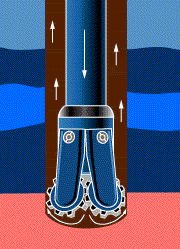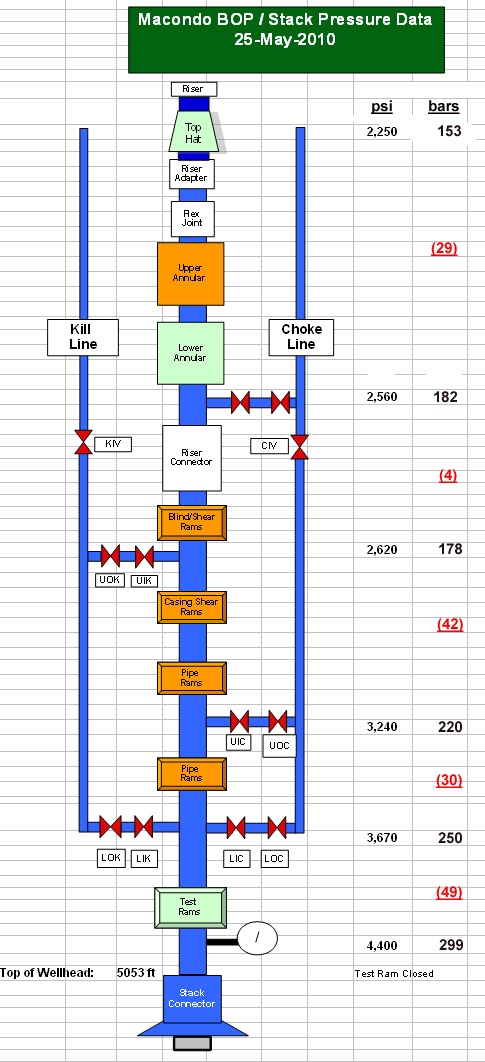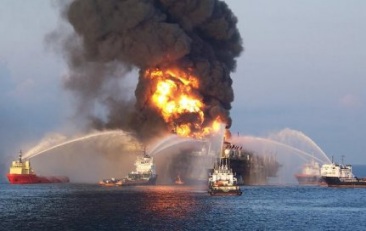Mud and the BOP
Mud and the christmas tree, aka a blowout preventer
(BOP) are the main means of control of a deepwater
oil well. People who drill for deepwater oil from
drill ships know the dangers. They know that an
unstoppable geyser of mud, methane and oil can erupt
if a mistake is made.
The patent for the rotary
drill bit bit was assigned to Howard Hughs, Sr.
in 1909. You could say the rotary drill bit launched
the Age of Oil. The drill bit is screwed into the
drill
pipe which extends all the way from the drillship
to the bottom of the well. The drillship rotates the
drill pipe to drive the drill bit. Drill pipe comes
in 33 foot sections that screw together. The drill
pipe is made of strong steel and it is typically 7
inches in diameter with 2 inch thick walls.
Here are two videos explaining oil well drilling.
http://www.youtube.com/watch?v=EUAaMHxCEC0&feature=related
http://www.youtube.com/watch?v=3Xu8COD5pgM
Mud
 A highly engineered fluid,
called mud, is forced down the drill pipe and up the
outside of the drill pipe to the drillship. There,
the cuttings are removed and the mud is sent down for
another round trip. The weight of the mud serves
another purpose. It prevents oil from rising to the
surface.
A highly engineered fluid,
called mud, is forced down the drill pipe and up the
outside of the drill pipe to the drillship. There,
the cuttings are removed and the mud is sent down for
another round trip. The weight of the mud serves
another purpose. It prevents oil from rising to the
surface.
It is possible to calculate the specific gravity (SP)
of the mud required to exactly balance the pressure
in the Macondo Prospect reservoir. It was explained
previously how to calculate reservoir pressure which
is 1142 bars. The pressure, in bars, due to the mud
in the drill pipe at the depth (5486 meters) of the
reservoir is;
pressure = SP * 5486 / 10
Set reservoir pressure equal to mud pressure and
solve for the specific gravity;
SP = 1142 / ( 5486 / 10 )
SP = 2.08
Mud with a specific gravity of 2.08 will neither ooze
down into the reservoir nor rise up. A near balanced
state is desired when drilling a deepwater well.
It is common to encounter pockets of liquid methane
while drilling. The methane is carried up with the
mud. The methane becomes a gas and so occupies much
greater space as it nears the surface. This rapidly
displaces mud which shoots up. In industry parlance,
the oil well has "kicked." The displaced mud also
means the well is unbalanced. Small, infrequent kicks
are only a small problem. They can be countered by
using heavier mud and pumping it faster. Big and
frequent kicks are a big problem. A really big kick
is a blowout--there is no sharp line.
Almost all deepwater oil wells kick, but the Macondo
Prospect well kicked more than most. This explains
why BP was behind schedule and impatient to move to
the next drilling site.
It is possible to make really heavy
mud by adding barium sulfate--which is also used
to make the barium enema used to visualize the colon
in x-rays.
The blowout preventer (BOP)
 The name
suggests that the BOP does only one thing--prevent
blowouts. But in reality, the BOP does many things.
The BOP is the second as well as the last line of
defense against blowouts. Everything passes through
the BOP including drill bits, drill pipe, well
casings, well liners, oil, gas, mud, cement etc. To
the right is a schematic diagram of the Deepwater
Horizon BOP. Almost everything on the BOP is
duplicated to make it failsafe. I found the schematic
at http://www.theoildrum.com/node/6611#more
The name
suggests that the BOP does only one thing--prevent
blowouts. But in reality, the BOP does many things.
The BOP is the second as well as the last line of
defense against blowouts. Everything passes through
the BOP including drill bits, drill pipe, well
casings, well liners, oil, gas, mud, cement etc. To
the right is a schematic diagram of the Deepwater
Horizon BOP. Almost everything on the BOP is
duplicated to make it failsafe. I found the schematic
at http://www.theoildrum.com/node/6611#more
The original comes from the Department of Energy.
http://www.energy.gov/open/oilspilldata.htm
The schematic actually comes from a spreadsheet. I
have added slightly to it. I will explain later.
http://www.energy.gov/open/documents/4.2_Item_1_BOP_Pressures_07_Jun_1200_Read_Only.xls
The "kill" and "choke lines" carry mud to the lower
part of the BOP. The lines originally ran alongside
the riser to the Deepwater Horizon. While drilling,
mud goes down the bore of the drill pipe.
One of the things the BOP can do is seal the gap
between the drill pipe and the well casing. There are
two of these and they are labeled "annular." They
might be activated if a kick occurs. They prevent mud
from coming up around the drill pipe.
If a hurricane is coming and you are in a hurry, you
might use the casing shear ram to disconnect the
drill ship from the well head. You have to remove the
drill pipe first.
If a blowout has occurred and all counter measures
have failed, you can activate the "blind shear ram".
It is the last chance to avert a catastrophe. It has
a blunt purpose. It shears the pipe casing and drill
pipe. This takes considerable force as the drill pipe
has thick walls and is made of strong steel.
The blind shear ram also completely and permanently
blocks the BOP. It can be activated from several
places on the drillship. It is also automatically
activated when the BOP looses hydraulic or electrical
connection with the drillship. The Deepwater Horizon
disaster occurred as a direct result of the blind
shear ram failing to do its job. The blind shear ram
is the only major BOP component not duplicated.
